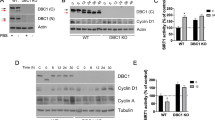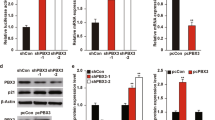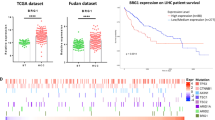Abstract
The human DLC-1 (deleted in liver cancer 1) gene was cloned from a primary human hepatocellular carcinoma (HCC) and mapped to the chromosome 8p21–22 region frequently deleted in common human cancers and suspected to harbor tumor suppressor genes. DLC-1 was found to be deleted or downregulated in a significant number of HCCs. We expanded our investigations to other cancers with recurrent deletions of 8p22, and in this study examined alterations of DLC-1 in primary human breast tumors, human breast, colon, and prostate tumor cell lines. Genomic deletion of DLC-1 was observed in 40% of primary breast tumors, whereas reduced or undetectable levels of DLC-1 mRNA were seen in 70% of breast, 70% of colon, and 50% of prostate tumor cell lines To see whether DLC-1 expression affects cell growth and tumorigenicity, two breast carcinoma cell lines lacking the expression of endogenous gene were transfected with the DLC-1 cDNA. In both cell lines, DLC-1 transfection caused significant growth inhibition and reduction of colony formation. Furthermore, introduction of the DLC-1 cDNA abolished the in vivo tumorigenicity in nude mice, suggesting that the DLC-1 gene plays a role in breast cancer by acting as a bona fide tumor suppressor gene.
This is a preview of subscription content, access via your institution
Access options
Subscribe to this journal
Receive 50 print issues and online access
$259.00 per year
only $5.18 per issue
Buy this article
- Purchase on Springer Link
- Instant access to full article PDF
Prices may be subject to local taxes which are calculated during checkout




Similar content being viewed by others
References
Arbieva ZH, Banerjee K, Kim SY, Edassery SL, Maniatis VS, Horrigan SK and Westbrook CA . (2000). Genome Res., 10, 244–257.
Boetter B and van Aelst L . (2002). Gene, 286, 155–174.
Borkhardt A, Bojesen S, Haas OA, Fuchs U, Bartelheimer D, Loncarevic IF, Bohle RM, Harbott J, Repp R, Jaeger U, Viehmann S, Henn T, Korth P, Scharr D and Lampert F . (2000). Proc. Natl. Acad. Sci. USA, 97, 9168–9173.
Cabeza-Arvelaiz Y, Sepulveda JL, Lebovitz RM, Thompson TC and Chinault AC . (2001). Oncogene, 31, 4169–4179.
Durkin ME, Yuan B-Z, Thorgeirsson SS and Popescu NC . (2002), Gene, 288, 119–127.
Euer N, Schwirzke M, Evtimova V, Burtscher H, Jarsch M, Tarin D and Weidle U . (2002), Anticancer Res., 22, 733–740.
Gustafson CE, Wilson PJ, Lukeis R, Baker E, Woolatt E, Annab L, Hawke L, Barrett J and Chenevix-Trench G . (1996).Cancer Res., 56, 5238–5245.
Homma Y and Emori Y . (1995). EMBO J., 14, 286–291.
Jaffe AB and Hall A . (2002). Adv. Cancer Res., 84, 57–80.
Jenkins R, Takahashi S, DeLacey K, Bergstralh E and Lieber M . (1998). Genes Chromosomes Cancer, 21, 131–143.
Martinez-Climent JA, Vizcarra E, Sanchez D, Blesa D, Marugan I, Benet I, Sole F, Rubio-Moscardo F, Terol MJ, Climent J, Sarsotti E, Tormo M, Andreu E, Sallido M, Ruiz MA, Prosper F, Siebert R, Dyer MJS and Garcia-Conde J . (2001). Blood, 98, 3479–3482.
Nagase T, Seki N, Ishikawa K, Tanaka and Nomura N . (1996). DNA Res., 3, 17–24.
Ng IO, Liang Z-D, Cao L and Lee TK . (2000), Cancer Res., 60, 6581–6581.
Ponting CP and Aravind L . (1999). Trends Biochem. Sci., 24, 130–132.
Qin LX, Tang ZY, Sham JS, Ma ZC, Ye SL, Zhou XD, Wu ZQ, Trent JM and Guan XY . (1999). Cancer Res., 59, 5662–5665.
Qin LX, Tang ZY, Ye SL, Liu YK, Ma ZC, Zhou XD, Wu ZQ, Lin ZY, Sun FX, Tian J, Guan XY, Pack SD and Zhuang ZP . (2001). J. Cancer Res. Clin. Oncol., 127, 482–488.
Sekimata M, Kabuyama Y, Emori Y and Homma Y . (1999). Biol. Chem., 274, 17757–17762.
Tikoo A, Czekay S, Viars C, White S, Heath JK, Arden K and Maruta H . (2000). Gene 257, 23–31.
Tirkkonen MTM, Karhu R, Kallioniemi A, Isola J and Kallioniemi OP . (1998). Genes Chromosomes Cancer, 21, 177–184.
Wilson PJ, McGlinn E, Marsh A, Evans T, Arnold J, Wright K, Biden K, Young J, Wainwright B, Wicking C and ChenevixTrench G . (2000). Human Mut., 15, 156–165.
Xu J, Zheng SL, Hawkins GA, Faith DA, Kelly B, Isaacs SD, Wiley KE, Chang B, Ewing CM, Bujnovszky P, Carpten JD, Bleecker ER, Walsh PC, Trent JM, Meyers DA and Isaacs WB . (2001). Am. J. Hum. Genet., 69, 341–350.
Yaremko ML, Kutza C, Lyzak J, Mick R, Recant WM and Westbrook CA . (1998). Genes Chromosomes Cancer, 21, 189–195.
Yoshioka K, Matsumara F, Akedo H and Itoh K . (1998). J. Biol. Chem., 273, 5146–5154.
Yuan BZ, Durkin ME and Popescu NC . (2002). Cancer Genet. Cytogenet., in press.
Yuan B-Z, Miller MJ, Keck CL, Zimonjic DB, Thorgeirsson SS and Popescu NC . (1998). Cancer Res., 58, 2196–2199.
Yuan B-Z, Thorgeirsson SS, Eyfjord J, Gudmundsdottir K and Popescu NC . (2000). Proc. Am. Assoc. Cancer Res, 41, 105.
Yuan BZ, Yang Y, Keck–Waggoner CL, Zimonjic DB, Thorgeirsson SS and Popescu NC . (1999). Cytogenet. Cell Genet., 87, 189–190.
Zimonjic DB, Keck-Waggoner CL, Yuan B-Z, Kraus MH and Popescu NC . (2000). Int. J. Oncol., 16, 221–230.
Zitzelsberger H, Lehmann L, Werner M and Bauchinger M . (1997). Histochem. Cell. Biol., 108, 403–417.
Author information
Authors and Affiliations
Corresponding author
Rights and permissions
About this article
Cite this article
Yuan, BZ., Zhou, X., Durkin, M. et al. DLC-1 gene inhibits human breast cancer cell growth and in vivo tumorigenicity. Oncogene 22, 445–450 (2003). https://doi.org/10.1038/sj.onc.1206064
Received:
Revised:
Accepted:
Published:
Issue Date:
DOI: https://doi.org/10.1038/sj.onc.1206064
Keywords
This article is cited by
-
Metastasis suppressor genes in clinical practice: are they druggable?
Cancer and Metastasis Reviews (2023)
-
Proteasomal turnover of the RhoGAP tumor suppressor DLC1 is regulated by HECTD1 and USP7
Scientific Reports (2022)
-
Frequent Downregulation and Promoter Hypermethylation of DLC1: Relationship with Clinical Outcome in Gallbladder Cancer
Journal of Gastrointestinal Cancer (2022)
-
DNA methylation landscape of triple-negative ductal carcinoma in situ (DCIS) progressing to the invasive stage in canine breast cancer
Scientific Reports (2020)
-
The Deleted in Liver Cancer 1 (Dlc1) tumor suppressor is haploinsufficient for mammary gland development and epithelial cell polarity
BMC Cancer (2015)



